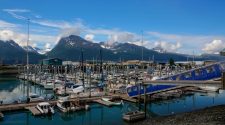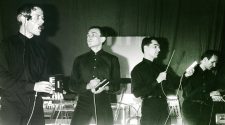Gov. Kate Brown activated the Oregon National Guard to help police protests in Portland early Wednesday evening after some demonstrators smashed windows of downtown businesses, officials said.
The damage by a small group of protesters also spurred the joint law enforcement command authorized by Brown to declare that gathering a riot. Dozens of state troopers responded and ordered people to leave. Officers said police arrested at least 10 people, including one person accused of throwing a Molotov cocktail toward police. Police said they also sized a rifle, ammunition, a knife, hammers and fireworks from some people arrested.
Yet as police and protesters clashed in one part of downtown, a peaceful protest for racial justice took place several blocks away. The demonstrations collectively attracted a few hundred people as the nation awaited the presidential election results.
President Donald Trump has regularly criticized the Portland demonstrations, which have occurred most nights since the Minneapolis police killing of George Floyd in late May. Trump sent in federal officers who frequently respond with force or clouds of tear gas.
Portland Mayor Ted Wheeler is a vocal critic of the federal response. But many protesters are also critical of Wheeler for failing to take swifter action to reform the city’s police response.
Wheeler won a second term Tuesday. The presidential race remains too close to call.
Brown had said she might send in Oregon National Guard members to respond to potential unrest after the election. Officials said the Guard would help in support roles such as processing arrests and blocking traffic. Several Humvees carrying National Guard members arrived in downtown after 8 p.m. Later, several National Guard members holding wooden batons stood among frontline riot police, forcing protesters to move.
“Oregon National Guard members are civilian community members helping to protect us,” said a statement issued by Brown’s joint command. “We don’t take this decision lightly.”
The statement said the Oregon National Guard would help “keep the community safe” and that members are trained in crowd control. They will wear military uniforms and work beside police, the statement said.
The governor’s decision comes hours after she extended her order giving control of policing protests to a joint law enforcement command led by Oregon State Police and the Multnomah County Sheriff’s Office. The agencies issued a statement cautioning people not to engage in criminal activity, or risk being tear gassed.
The demonstrations began at two separate points, one in Northwest Portland and one in Southeast Portland. Both events began as rallies and evolved into marches as the sun set.
The Northwest Portland gathering, held in the North Park Blocks downtown, was billed as the first in a post-election week of action. About 200 people started marching from the park around 5:20 p.m.
At the same time, a similarly sized group marched west across the Morrison Bridge toward the downtown waterfront. People carried signs that said “Count every vote.”
“Hey, hey! Ho, ho! Donald Trump has got to go!” marchers shouted.
By 5:45 p.m., both marches had reached Southwest Naito Parkway. The two groups converged beneath the Burnside Bridge.
Leaders of the separate groups urged marchers to unite and set aside philosophical differences about how to protest, namely whether or not to carry out “direct actions,” typically meant to draw out police. Many organizers in the Black-led march from Southeast Portland have criticized direct action tactics such as damaging police buildings, because they believe that takes away from the message of Black Lives Matter.
But the union between the distinct marches was brief. About 150 people affiliated with the direct action march left the area and began walking west. Some people in the crowd broke windows of a hotel and a church, among other buildings.
Brown authorized a joint state and county command to police the protests, and Lines of dozens of police officers wearing riot gear arrived and forced people to move. Some people continued to break windows at nearby businesses, including at least two small businesses. Police declared the gathering a riot around 7 p.m., as the group walked near Southwest 12th Avenue and Alder Street. Some people threw gas bottles at officers responding to the scene.
The standoff between state police and protesters ended after several minutes, but not before prompting the Portland Streetcar to cancel service for the rest of the night.
Brown’s joint command also announced her decision to send in the Oregon National Guard. The exact details of their assignment remains unclear.
Meanwhile, about 150 people remained at the downtown waterfront demonstration near the Skidmore Fountain, where they listened to speeches and musical performances by people of color. The demonstration was entirely peaceful, and it had a distinctly different tenor than the march that unfolded simultaneously several blocks west.
Police retreated from that group around 7:30 p.m., but then returned 20 minutes later to force the crowd to leave. Police pressed people several blocks east, then north. Officers surrounded several dozen protesters on Southwest Five Avenue, approaching from Alder and Washington streets. The two sides faced off for several minutes. Protesters shouted at officers, who eventually forced people farther west. Police pushed some people and detained at least two others.
“There is criminal activity occurring in this crowd affecting the safety of others and causing immediate property damage,” one officer said on a loudspeaker.
By 8:30 p.m., dozens of demonstrators remained downtown, chanting as a police line looked on. After police pulled back, about 150 people marched several blocks to the Justice Center, a city-county building that has been at the center of protests.
People mostly stood around in the parks across Third Avenue from the building until 10 p.m., when the crowd began marching north and west. Police approached after the crowd walked several blocks, and after a brief standoff, ordered people to leave. Marchers moved north on Broadway, where some people shattered the windows of a Starbucks inside Pioneer Courthouse Square.
Police and National Guard members returned to the crowd and advanced, forcing people to move west.
Demonstrators also gathered Tuesday night, including at an hours-long march that wrapped through Southeast Portland. Protesters often chant a list of demands, including Wheeler’s resignation and $50 million in cuts to Portland police.
The City Council will likely vote Thursday on $18 million in proposed cuts. But it’s unclear whether Commissioners Jo Ann Hardesty and Chloe Eudaly will gain the necessary third vote to approve the cuts.
Jayati Ramakrishnan, Sean Meagher and Brooke Herbert contributed to this report, which will be updated throughout Wednesday.
— Dave Killen, Shane Dixon Kavanaugh, Beth Nakamura and Jim Ryan
Subscribe to The Oregonian/OregonLive newsletters and podcasts for the latest news and top stories.




![Here Are The Best Deals [Updated]](https://newsfortomorrow.com/wp-content/uploads/2019/12/1577616733_Here-Are-The-Best-Deals-Updated-225x125.jpg)











